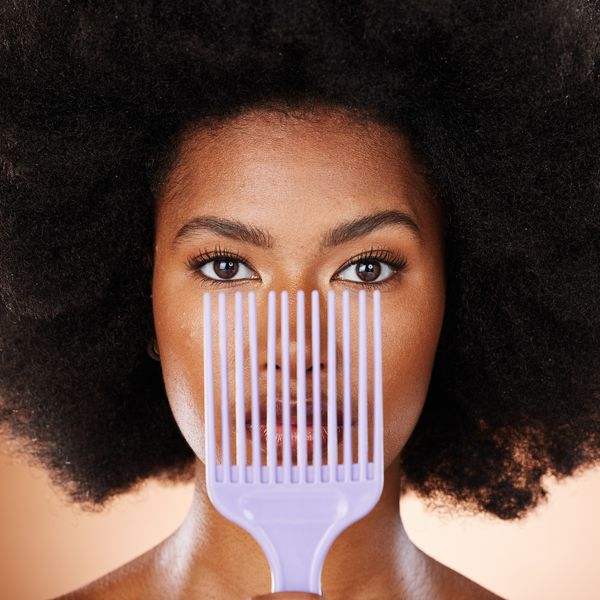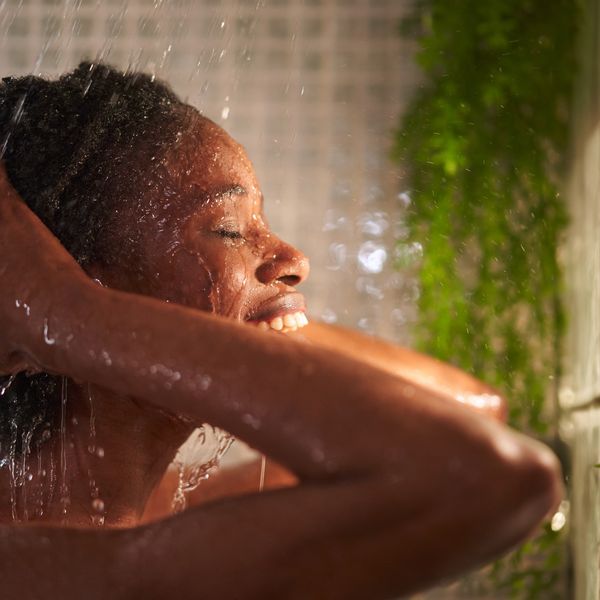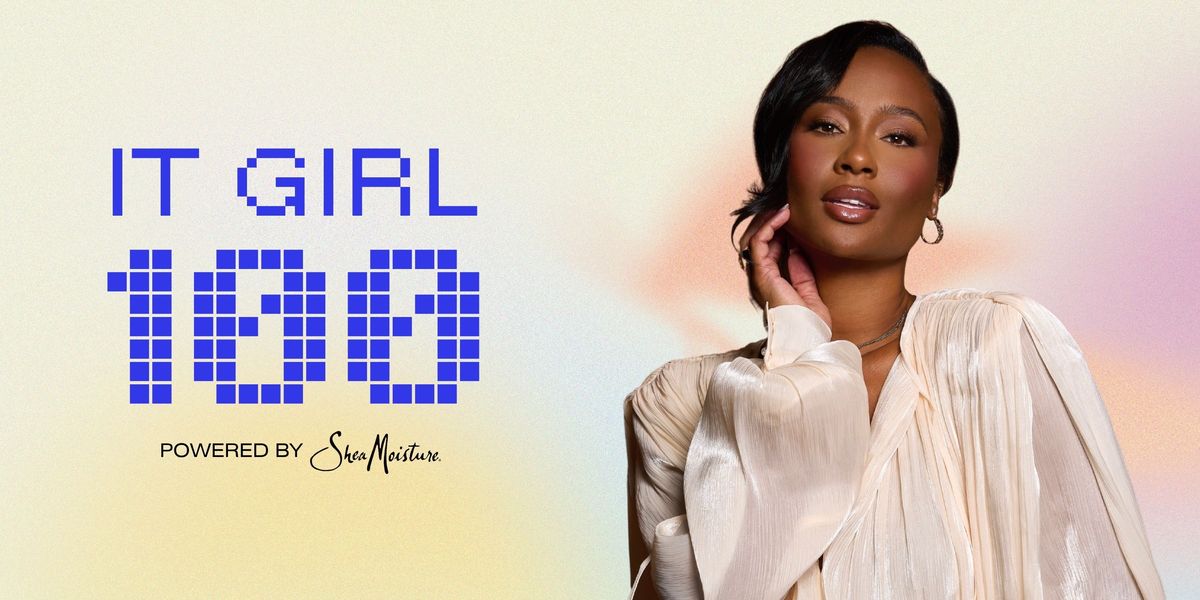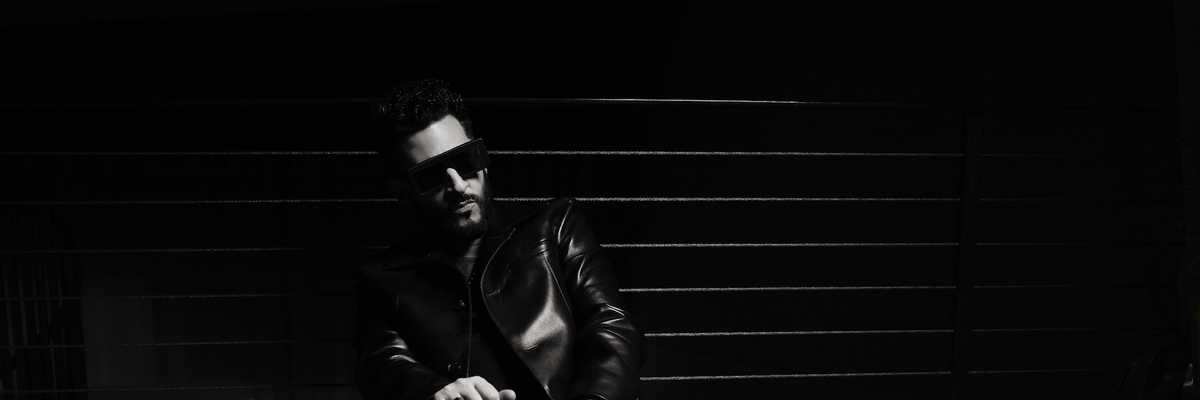
As much as I like cold weather (and I do, unapologetically so), I have learned that it's not the best for my hair. For one thing, did you know that warm temps are far better at holding in moisture than cold ones are? Another problem is freezing weather and wind can cause the cuticles of our hair to lift which can result in hair strand damage and/or hair not being able to hold conditioning products in for very long. Also, when it's cold, that can lead to more frizzing and dryness; especially because we tend to be indoors more often with our HVAC units set to warmer temps.
All of these reasons are why it's so important to be proactive when it comes to caring for your hair during the fall and winter seasons. So, if you're looking for a few ways to do just that right about now, I've got 10 tips that will safely carry your tresses right on past Valentine's Day — and then some.
1. Do Some Pre-Pooing
Even if you use a sulfate-free shampoo (and I hope that you do because other than clarifying your hair, sulfates can be extremely drying), when you're a Black woman, it's still a good idea to pre-poo your hair on every wash day. Since it can be difficult for the natural sebum from your hair follicles and scalp to run down the entire shaft of your strands (due to your super curly texture), that's why your hair tends to be drier than other ethnicities. Then, when you bring shampoo into that mix, that can dry your locks out even more. One way to head that off is by pre-pooing — applying an oil to your hair, before shampooing. This works well because it softens your hair, makes your conditioner more effective and it significantly reduces the detangling process, so that there's far less breakage (which is a great thing because wet hair is pretty fragile).
As far as the best oils to use, I like avocado a lot because it's got a great reputation for containing properties that detangle, deeply moisturize, and even heal dandruff. Still, pretty much any oil of your choice (argan, coconut, grapeseed, olive, almond, etc.) will work. Just split your hair up into four sections, generously apply the oil, let it sit for 20-30 minutes, and wash and rinse as usual. You will immediately notice a difference.
2. Give Your Hair Herb-Infused Hot Oil Treatments
Something that I've been doing this year that I enjoy so much is making my own herb-infused oils. If you check out the article, "12 Natural Ways To Get Your Skin To Glow All The Way Up This Summer" that I wrote for this platform, #5 breaks it down for you. For now, I'll just say that this kind of oil is bomb because you can customize the herbs and oil(s) that you want in order to pamper your skin or, in this case, your hair.
Anyway, remember how I said that cold air can cause cuticles to take quite a beating? One way to avoid this is treating your hair to a hot oil treatment because it helps to seal your cuticles. Not only that but the heat of the oil will stimulate blood flow to your hair follicles which will strengthen your hair over time. Plus, hot oil treatments are great at reducing split ends and alleviating dry scalp. Applying a hot oil treatment every other wash day is cool. For tips on how to do it properly, check out YouTuber's Mia Nicole's video here, Leilani Iman's video here, and tatenda's video here.
3. Apply a Leave-In Conditioner
Even though I am big on deep conditioning (especially over the past couple of years), something that I wish I had been doing for even longer than that is applying a leave-in conditioner. Because my hair soaks up moisture with the quickness (no matter what the season may be), applying a leave-in (usually on freshly washed hair and right before I blow it out) has helped my hair to retain moisture for days on end. As far as if you should apply it every day, honestly, I think it depends on if you go with a cream or a spray (a spray is usually much lighter). Also, it's important to keep in mind that "too much of a good thing" can result in a lot of build-up and residue on your hair. Personally, on wash day and maybe once a week is more than enough in my opinion. The bottom line here is to use some, especially during the cooler seasons of the year. For tips on choosing the right leave-in for your hair and its needs, check out Naturally Curly's "Top 20 Leave-in Conditioners."
4. Use a Cream-Based Thermal Heat Protectant
Listen, I would audibly scream it in your ear if I could — ANY TIME YOU APPLY HEAT TO YOUR HAIR, YOU NEED TO USE A THERMAL HEAT PROTECTANT FIRST! It adds and seals in moisture. It reduces frizz. It provides a layer of protection from the heat. Just make sure during this time of the year that, unless you have very fine hair, you go with a cream rather than a spray base. While I can't recall her name, shout-out to the sales associate at one of my local Sally's Beauty Supply stores who told me that cream gives better and longer-lasting coverage than a spray. She's exactly right. I can totally notice a difference between the two since switching over to creams.
5. (Temporarily) Ditch Serums
As with most things in life, hair serums come with pros and cons. On one hand, they help to control frizz, reduce detangling and create an unbelievable amount of shine. On the flip side, they can create a significant amount of build-up, can weigh your styles down and, because of the chemicals in them, cold weather can actually cause serums to make your hair feel really stiff. The solution? Well, just like it's best to go with a cream-based thermal heat protectant when it's cold outside, it's a good idea to style your hair altogether with something that is more of a cream-base so that your hair feels softer and is easier to manage. That said if you absolutely must go with a serum, use one that is oil-based instead of silicone-based. You will be able to avoid the "stiffness" easier that way.
6. Shower in Warm (Not Hot) Water
I'll agree with anyone who feels like nothing feels better than a long hot shower after coming in from the freezing cold. Here's the problem, though — because your hair is pretty porous, if hot water hits it, that can result in it dehydrating your scalp and stripping your strands of the natural oils that they need in order to thrive. So, if "hot you must", avoid shampooing in the shower. And wherever you wash your hair, go with warm for the washing and cool for the final rinse. Cool water is something else that is great when it comes to sealing your cuticles right on up.
7. Protect Your Ends
A lot of the Black women I know will actually put their hair into a protective style during the summertime either because they are traveling a lot or they simply don't want to be bothered with thinking about it. But you know what? Fall and winter are ideal for braids, twists, wigs, and weaves because they are so good at protecting your hair — especially your ends — from inclement weather. Speaking of your ends, because you won't be able to retain any inches (check out "Let's Gain An Inch A Month Of Hair Growth 'Til December, Shall We?", "This Is The Way To Properly Care For Your Hair While Rockin' A Wig" and "If Your Hair Keeps Breaking Off, You're Probably Doing This.") unless they are able to remain healthy and intact, definitely make sure that you seal them on every wash day. All this means is you plan to apply some extra oil to them (after conditioning your hair), so they won't get dry and brittle as quickly. For tips on how to properly seal your ends, check out Simply Julia Lauren's YT video (here) and ulovemeg's video (here).
8. Make Vitamin E Your Hair’s Best Friend
Something that will definitely support your hair's health on all fronts is Vitamin E. The potent antioxidants in it will help to moisturize your scalp and soothe it if it's irritated or itching. It's the kind of oil that is extremely hydrating. If you're looking for an oil that will help to restore hair loss, there are studies to support its ability to do that. Vitamin E can also give your hair a lot of shine.
For all of these reasons and more, it's a good idea to make sure your diet contains foods that are high in Vitamin E (like almonds, broccoli, spinach, sunflower seeds, butternut squash, avocado, and kiwi), that you use hair products that contain Vitamin E and that you massage your scalp with some 100 percent pure Vitamin E oil, once a week, too.
9. Drink Herbal Teas
A couple of years ago, I penned "These Foods Will Give Your Skin & Hair The Moisture They Crave" for xoNecole because, it's important to remember that, when it comes to keeping moisture in your hair, it needs to happen from the inside out, just as much as it does from the outside in. One of the things I mentioned on this list is herbal teas because 1) teas are a great way to hydrate your hair and scalp and 2) teas are very popular around this time of year. As far as the kind of herbal teas that are especially good for hair health, some of those include rosemary (it increases blood circulation to your scalp); lavender (it reduces dandruff and soothes an itchy scalp); ginger (it reduces hair fall); peppermint (it encourages hair growth) and red clover tea (it adds additional moisture).
10. Use a Humidifier at Night
I've been saying, on repeat, that since it appears that COVID isn't going anywhere, any time soon, it's really important to invest in a humidifier. You can read all about why by checking out "10 Really Good Reasons To Get Yourself A Humidifier This Fall." As it relates to your hair, specifically, sleeping with a humidifier at night is an effective way to restore the moisture that your HVAC unit may be zapping from your hair. Since I've been using one, it's kind of wild how my scalp has been itching less and my hair has been feeling less dry. It's one of the best hair (and skin) investments that I've made in a long time as I prepare for all that fall and winter have in store. If you don't have one, treat yourself. You — and your hair — won't regret it at all.
Featured image by Getty Images
- Hair Breakgage: Reasons Natural Hair Is Breaking Off - xoNecole ... ›
- Does Blue Magic Hair Grease Make Your Hair Grow? - xoNecole ... ›
- 10 Things Your Natural Hair Needs In The Winter ›
- Best Fall Foods For Hair Growth: What To Eat For Length - xoNecole ›
Exclusive: Viral It Girl Kayla Nicole Is Reclaiming The Mic—And The Narrative
It’s nice to have a podcast when you’re constantly trending online. One week after setting timelines ablaze on Halloween, Kayla Nicole released an episode of her Dear Media pop culture podcast, The Pre-Game, where she took listeners behind the scenes of her viral costume.
The 34-year-old had been torn between dressing up as Beyoncé or Toni Braxton, she says in the episode. She couldn’t decide which version of Bey she’d be, though. Two days before the holiday, she locked in her choice, filming a short recreation of Braxton’s “He Wasn’t Man Enough for Me” music video that has since garnered nearly 6.5M views on TikTok.
Kayla Nicole says she wore a dress that was once worn by Braxton herself for the Halloween costume. “It’s not a secret Toni is more on the petite side. I’m obsessed with all 5’2” of her,” she tells xoNecole via email. “But I’m 5’10'' and not missing any meals, honey, so to my surprise, when I got the dress and it actually fit, I knew it was destiny.”
The episode was the perfect way for the multihyphenate to take control of her own narrative. By addressing the viral moment on her own platform, she was able to stir the conversation and keep the focus on her adoration for Braxton, an artist she says she grew up listening to and who still makes her most-played playlist every year. Elsewhere, she likely would’ve received questions about whether or not the costume was a subliminal aimed at her ex-boyfriend and his pop star fiancée. “I think that people will try to project their own narratives, right?” she said, hinting at this in the episode. “But, for me personally – I think it’s very important to say this in this moment – I’m not in the business of tearing other women down. I’m in the business of celebrating them.”
Kayla Nicole is among xoNecole’s It Girl 100 Class of 2025, powered by SheaMoisture, recognized in the Viral Voices category for her work in media and the trends she sets on our timelines, all while prioritizing her own mental and physical health. As she puts it: “Yes, I’m curating conversations on my podcast The Pre-Game, and cultivating community with my wellness brand Tribe Therepē.”
Despite being the frequent topic of conversation online, Kayla Nicole says she’s learning to take advantage of her growing social media platform without becoming consumed by it. “I refuse to let the internet consume me. It’s supposed to be a resource and tool for connection, so if it becomes anything beyond that I will log out,” she says.
On The Pre-Game, which launched earlier this year, she has positioned herself as listeners “homegirl.” “There’s definitely a delicate dance between being genuine and oversharing, and I’ve had to learn that the hard way. Now I share from a place of reflection, not reaction,” she says. “If it can help someone feel seen or less alone, I’ll talk about it within reason. But I’ve certainly learned to protect parts of my life that I cherish most. I share what serves connection but doesn’t cost me peace.
"I refuse to let the internet consume me. It’s supposed to be a resource and tool for connection, so if it becomes anything beyond that I will log out."
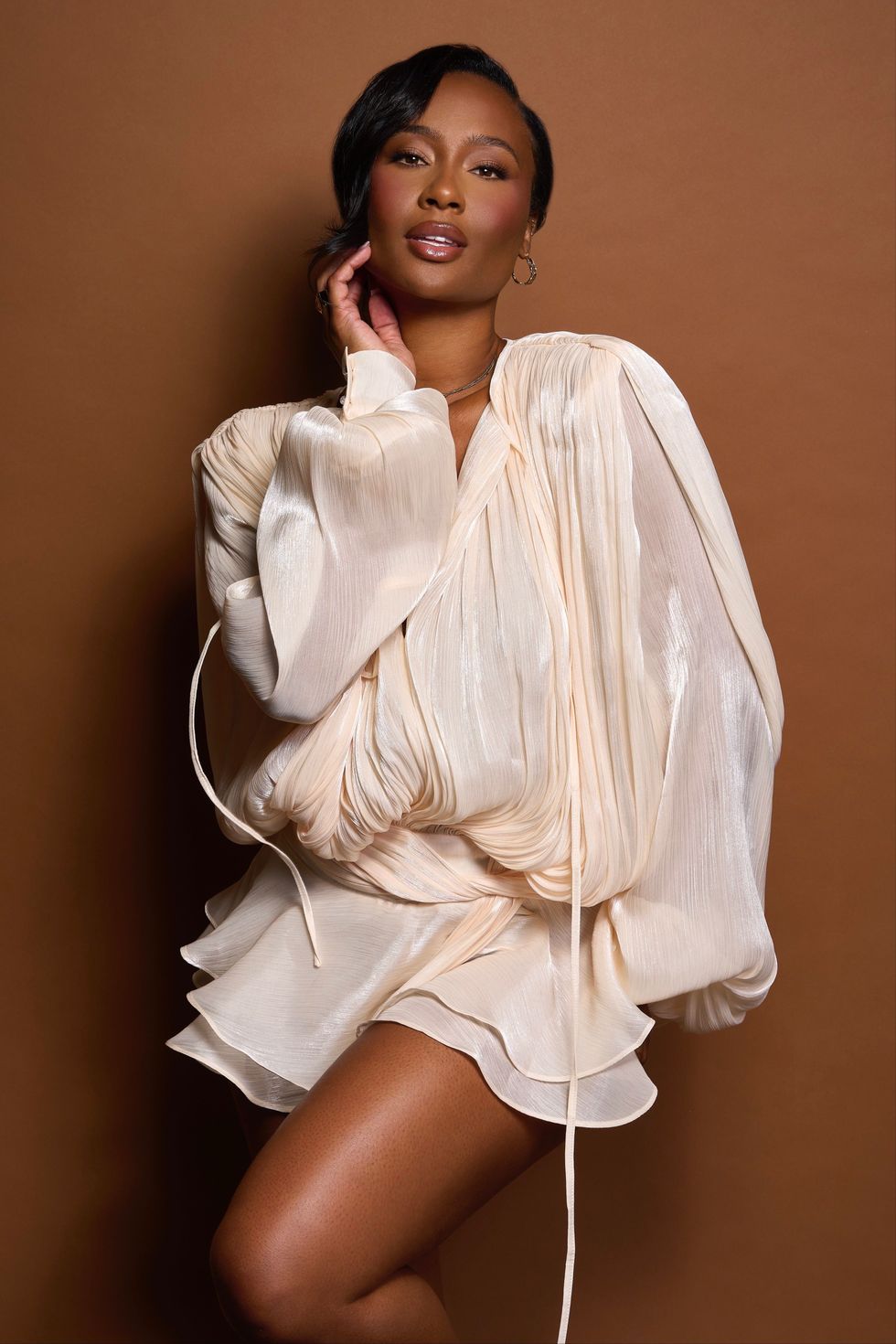
Credit: Malcolm Roberson
Throughout each episode, she sips a cocktail and addresses trending topics (even when they involve herself). It’s a platform the Pepperdine University alumnus has been preparing to have since she graduated with a degree in broadcast journalism, with a concentration in political science.
“I just knew I was going to end up on a local news network at the head anchor table, breaking high speed chases, and tossing it to the weather girl,” she says. Instead, she ended up working as an assistant at TMZ before covering sports as a freelance reporter. (She’s said she didn’t work for ESPN, despite previous reports saying otherwise.) The Pre-Game combines her love for pop culture and sports in a way that once felt inaccessible to her in traditional media.
She’s not just a podcaster, though. When she’s not behind the mic, taking acting classes or making her New York Fashion Week debut, Kayla Nicole is also busy elevating her wellness brand Tribe Therepē, where she shares her workouts and the workout equipment that helps her look chic while staying fit. She says the brand will add apparel to its line up in early 2026.
“Tribe Therepē has evolved into exactly what I have always envisioned. A community of women who care about being fit not just for the aesthetic, but for their mental and emotional well-being too. It’s grounded. It’s feminine. It’s strong,” she says. “And honestly, it's a reflection of where I am in my life right now. I feel so damn good - mentally, emotionally, and physically. And I am grateful to be in a space where I can pour that love and light back into the community that continues to pour into me.”
Tap into the full It Girl 100 Class of 2025 and meet all the women changing game this year and beyond. See the full list here.
Featured image by Malcolm Roberson
Jon B. Talks New Album, 18-Year Marriage & Being A Girl Dad
Since 1995, Jon B. has been entertaining us with his soulful voice, belting out R&B classics like “They Don’t Know” and “Someone to Love.” Despite his immense success, Jon decided to prioritize his family and take a step back from the music scene. He got married, and together, he and his wife had daughters. While he didn’t release any new music during this period, Jon remained dedicated to his fans by touring and maintaining his connection with them.
"I'm raising two daughters," he tells xoNecole exclusively. "One is 11 now, and one is 18, and both need their dad. Besides being a father, a rock star on the weekends, and a husband of 18 years, the real thing that kept me the busiest over the last 10 years was the road, keeping the bread on the table, and staying with my fans. Nevertheless, connecting with the fans and keeping that relationship alive. Regardless of whether I was on the radio every five minutes or whatnot. I just wanted to keep that relationship alive, and the best way to do that is just go and perform."
A decade later, Jon B. dropped a new album, WAITING on YOU. The album title alone is a nod to fans who have been waiting on him to release new music. The "Are You Still Down" singer collaborated with Rick Ross, Alex Isley, Tank, and Donell Jones on the album, giving fans a little bit of everything.
"Compiling this album was a labor of love because it was me sort of picking the gems. I wrote so many songs over the last 30 years. I wanted to go back and dust some old gems off and see if I can rework these records," he says. "Some of them are kind of reworks from back in the day, from back in the late '90s. I just kind of love the beat. One of the songs on my album is a vintage cut. I'll call it a vintage cut because I did it in '98. It's a song called "Pick Me Up."
"There's a little bit of the old and a little bit of the new, but WAITING on YOU, I felt was an appropriate name for the album, being that it was 10 years and it's really about my relationship that I have with my fans. Not only is it the relationship I have with my wife and my children, it's the extended relationship I have with with you guys, the listeners."
"There's a little bit of the old and a little bit of the new, but WAITING on YOU, I felt was an appropriate name for the album, being that it was 10 years and it's really about my relationship that I have with my fans."
His wife and kids are his biggest supporters and he shared that they sometimes give their opinion on his music. When it comes to his relationship with his wife, he says communication and patience are the keys to lasting. "I don't mean to sound like Dr. Phil up in here, but 18 years, going on 19, and it's like, I'm not counting, but I guess we're doing something right because we're very happy people," he says.
"I'm making music that reflects what I feel in my heart, which is pretty cool to share with the world now as a grown ass man instead of a guy who was growing up and had an old soul and I was figuring stuff out. I'm grateful for those records, but I really feel like these records are like a guy celebrating everything that I've been blessed to experience so far."
Let’s make things inbox official! Sign up for the xoNecole newsletter for love, wellness, career, and exclusive content delivered straight to your inbox.
Feature image courtesy





